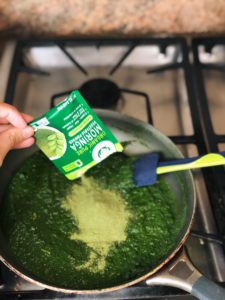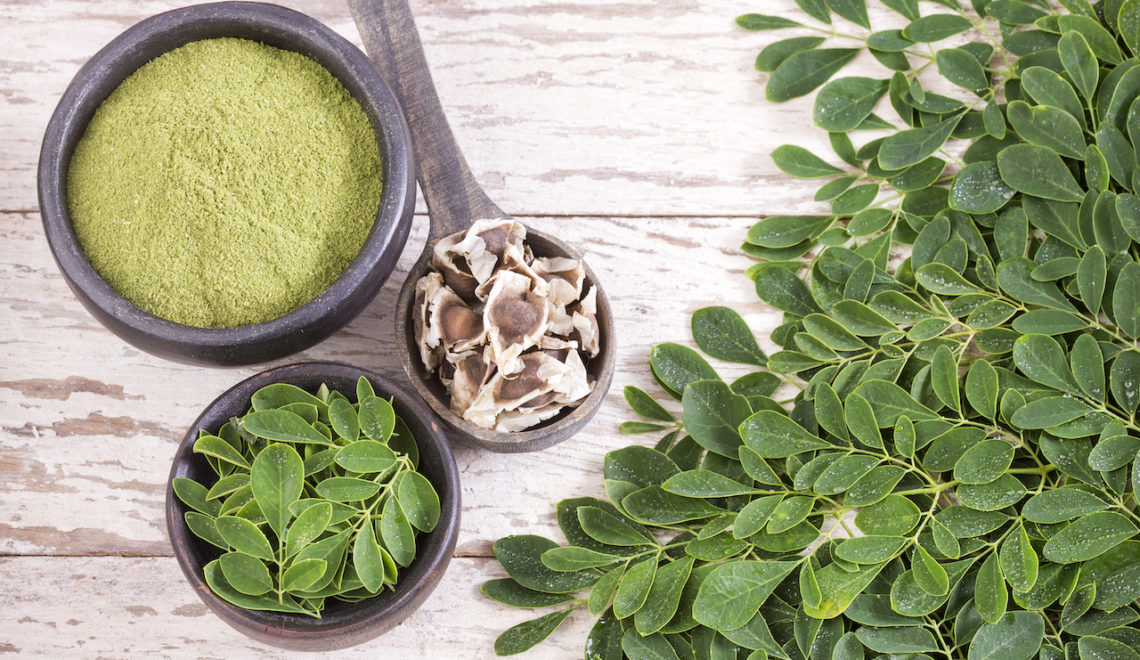Ever wonder how much moringa is enough to maximize the benefits? Incorporating Moringa oleifera in meal planning should be easy, right? It can be hard finding out how much of any superfood to consume. Like many nutrition-rich foods, we recommend you treat moringa dosage with care, and listen to your body.
Whether consuming moringa for overall health or increased energy, many people are uncertain exactly how much moringa they need to maximize benefits. The various health-enhancing uses for moringa are well-known. Moringa can help treat diabetes, high blood pressure, digestive disorders, inflammatory conditions, anemia, skin disorders, parasitic diseases and joint pain. Overall, moringa can also improve cardiovascular and immune function too.
Yet, simply knowing the benefits is not enough, so we hope this article clarifies some things!
how much moringa is enough?
Given moringa’s high nutritional value and healing properties, this superfood can be used daily, in small doses. We have an article on 10 Reasons to Eat Moringa Everyday, if you’d like a quick overview of some of these nutritional benefits.
Moringa encourages the removal of toxins through its support of liver and kidney function. When used environmentally, even the moringa seeds do an amazing job of removing contaminants from water. [2]
Like most plant foods, the dried powder is more potent than eating fresh moringa leaves. We like the simple tip that “less is more” when it comes to adding superfoods like moringa to your daily routine. When adding Kuli Kuli’s Pure Moringa powder to recipes, start with 1 teaspoon.
Moringa Dosage
Research shows that taking moringa powder every day, even 50 mg/kg of body weight, successfully reduces oxidative stress in the body–that’s the equivalent of approximately 1.5 teaspoons for someone weighing 150 pounds. [5] On the other end of the spectrum, animal studies using Moringa oleifera extract revealed delayed tumor growth and increased life span at a dosage of 500 mg/kg of body weight. [9]
So what does this mean?
Taking 1 tablespoon of moringa powder is the equivalent of eating 1 cup of leafy greens, but if a person is new to increasing their “greens” quotient, this may feel like too much too fast. As a result, the body’s efforts to detoxify could happen too quickly causing potential aggravations such as temporary loose stools. [8]
The body needs time to adjust and every individual has unique body chemistry. It’s best to start slow by taking 1 teaspoon if adding to a personal smoothie or single-serving meal, or use 1 tablespoon for a family dish.
Can Moringa Be Used Everyday?
Moringa is safe to use on a daily basis but this can vary from person to person. It’s always best to listen to your own body signals. Some people may find they only need 1 teaspoon every other day, while others may want to consume it more frequently. When managing chronic conditions such as overweight, Type 2 diabetes, inflammation or intestinal conditions, a daily amount may be most beneficial.
Moringa has strong effects that improve blood sugar control and reduce lipids in diabetic patients, so it can be used for prevention as well as management of blood sugar disorders. [6][10] In a study using Moringa oleifera, Murraya koeingii and Curcuma longa (Ratio 6:3:1), obese patients on the herbal formula showed a 17% reduction in serum glucose, 16.43% reduction in triglycerides and 12.6% improvement in LDL/HDL ratios. [7]
Whatever amount you decide is right for you, the best results are achieved by using moringa regularly.
Versatility of Moringa
Looking deeper into a few specific conditions helps to paint an exciting picture of moringa’s exceptional versatility. Malnourishment continues to be a major concern worldwide, and moringa offers a powerful means of alleviating this chronic problem. For example, in a community-based feeding program in Uganda, underweight children were successfully able to gain weight during a 5-week study that provided a daily food supplement made of ground soybeans, peanuts and Moringa oleifera. [3]
In a study on Thai diabetes patients, those on conventional medications for the condition took moringa powder in capsule form for up to 12 months. Supplementing with moringa proved to lower blood sugar levels as well as HbA1c and Fasting Plasma Glucose (FPG) levels. [6]
Inflammatory Bowel Diseases (IBD) such as Crohn’s disease and ulcerative colitis are becoming more and more common. Ulcerative colitis (UC), a condition causing recurring inflammation of the gastrointestinal tract, is usually treated with prescription anti-inflammatory medications to reduce symptoms. A major drawback is the fact that long-term drug use poses serious problems because of intense side effects.
Moringa can help these ailments with its anti-inflammatory benefits and has even demonstrated the ability to reduce inflammation, diminish erosion of the intestinal lining, and repair damaged tissue in acute UC conditions. [4]
Other Parts of the Moringa Tree
Although Kuli Kuli focuses on the most nutrient dense part of the tree, the leaves, every single part of the tree from the seeds, roots, trunk, flowers, and leaves, has nutritional, medicinal and technical benefits. We have an article reviewing What Are the Parts of a Moringa Tree and Their Benefits, if you’d like a more in-depth review.
Some online sources suggest the roots of the Moringa oleifera tree are safe to ingest, but the roots contain a toxic alkaloid called spirochin which can cause paralysis and death, and should not be consumed. [4]
Moringa leaves, pods, seeds and flowers are completely safe. The bark is usually reserved for therapeutic use in reducing the progression of malignant growths. [1]
If pregnant, do not use moringa root, bark or flowers, as their plant chemicals may cause the uterus to contract. [11]
Key Takeaway
When taking moringa powder for maintenance in healthy individuals, 1 teaspoon regularly works well. This is equivalent to 2 grams. Unless a laxative effect is desired, moringa is best taken with food. You can add 1 teaspoon to your smoothies, or any stews, sauces, and savory dishes too. If taking medication, please consult your physician to ensure you remain free of any potential medicinal/herbal interactions.
Need inspiration? We have tons of wonderful moringa recipes for you to liven up your daily eating routine and jumpstart your healthy healing journey.
At Kuli Kuli, we believe that moringa is one piece of the larger health puzzle. Has moringa helped you find the energy you need? Let us know in the comments!

Follow us @kulikulifoods or leave us a comment so we can see some of your favorite ways to enjoy the benefits of this miracle tree.
References
- Al-Asmari, A., Sulaiman, M. A., Athar, T., Khan, A. Q., Al-Shahrani, H., & Islam, M. (2015). Moringa oleifera as an anti-cancer agent against breast and colorectal cancer cell lines.PLoS One, 10(8) doi:http://dx.doi.org/10.1371/journal.pone.0135814
- Anwar, F., Ashraf, M., & Muhammad, I. B. (2005). Interprovenance variation in the composition of moringa oleifera oilseeds from pakistan.JAOCS, Journal of the American Oil Chemists’ Society, 82(1), 45-51. Retrieved from https://search.proquest.com/docview/275086507?accountid=107221
- Jilcott, S. B., Ickes, S. B., Ammerman, A. S., & Myhre, J. A. (2010). Iterative design, implementation and evaluation of a supplemental feeding program for underweight children ages 6-59 months in western uganda.Maternal and Child Health Journal, 14(2), 299-306. doi:http://dx.doi.org/10.1007/s10995-009-0456-3
- Kim, Y., Wu, A. G., Jaja-Chimedza, A., Graf, B. L., Waterman, C., Verzi, M. P., & Raskin, I. (2017). Isothiocyanate-enriched moringa seed extract alleviates ulcerative colitis symptoms in mice.PLoS One, 12(9) doi:http://dx.doi.org/10.1371/journal.pone.0184709
- Leone, A., Spada, A., Battezzati, A., Schiraldi, A., Aristil, J., & Bertoli, S. (2015). Cultivation, genetic, ethnopharmacology, phytochemistry and pharmacology of moringa oleifera leaves: An overview.International Journal of Molecular Sciences, 16(6), 12791-12835. doi:http://dx.doi.org/10.3390/ijms160612791
- Putthapiban, P., Sukhumthammarat, W., & Sriphrapradang, C. (2017). Concealed use of herbal and dietary supplements among thai patients with type 2 diabetes mellitus.Journal of Diabetes & Metabolic Disorders, 16doi:http://dx.doi.org/10.1186/s40200-017-0317-3
- Sengupta, K., Mishra, A. T., Rao, M. K., Sarma, K. V. S., Krishnaraju, A. V., & Trimurtulu, G. (2012). Efficacy and tolerability of a novel herbal formulation for weight management in obese subjects: A randomized double blind placebo controlled clinical study.Lipids in Health and Disease, 11, 122. doi:http://dx.doi.org/10.1186/1476-511X-11-122
- Taweerutchana, R., Lumlerdkij, N., Vannasaeng, S., Akarasereenont, P., & Sriwijitkamol, A. (2017). Effect of moringa oleifera leaf capsules on glycemic control in therapy-naïve type 2 diabetes patients: A randomized placebo controlled study.Evidence – Based Complementary and Alternative Medicine, 2017, 6. doi:http://dx.doi.org/10.1155/2017/6581390
- Tiloke, C., Phulukdaree, A., & Chuturgoon, A. A. (2013). The antiproliferative effect of moringa oleifera crude aqueous leaf extract on cancerous human alveolar epithelial cells.BMC Complementary and Alternative Medicine, 13, 226. doi:http://dx.doi.org/10.1186/1472-6882-13-226
- Toma, A., Makonnen, E., Mekonnen, Y., Debella, A., & Addisakwattana, S. (2014). Intestinal alpha]-glucosidase and some pancreatic enzymes inhibitory effect of hydroalcholic extract of moringa stenopetala leaves.BMC Complementary and Alternative Medicine, 14, 180. doi:http://dx.doi.org/10.1186/1472-6882-14-180
- Web MD. (n.d.). Moringa: Side effects & safety. Retrieved from https://www.webmd.com/vitamins/ai/ingredientmono-1242/moringa













Great article thank you!
Hi, this is Peter
Thank you for this article as I have a health concern and am trying to find out how much moringa I might aim for to consume. I have to go for a biopsy for my prostate in a few weeks and am making moringa smoothies twice a day with about 5 or 6 grams of powder, fruit and honey daily. They found something suspicious in the MRI and am doing what I can to increase my chances of a benign result or even cant find the problem. Obviously I’m not asking for medical advice but from your experience and knowledge do you believe I am consuming enough. I’m 63 and 90kg
Hi Peter, thanks for your question. We wish you well wishes and good health and recovery. In our “How Often Should I Eat Moringa” article, for a 150 lbs adult, we recommend a daily serving size of 5-10 grams. Please always check with your doctor if you have additional questions; in general, as long as you are eating between 5-10g/day, it is a healthy amount.
Hello, how far do the roots of moringa tree extend?
Moringa has few side effects …lowering BP.
So worried .
57yrs old ..90kgweight
D2VERTEBRA FRACTURE
DOC.SUGGESTED BONFAST TABLET CONTAINING ( MORINGA 100 MG AND CISSUS QUADRAANGULARIS 500 MG ..)
TAKING ONE TABLET DAILY …
HOW MANY MONTHS SHOULD I TAKE
AS I CANT GO CALCIUM TABLETS DUE TO CONSTIPATION .I STOPPED THAT .
IS MORINGA SAFE ??
Hi Sneha, thanks for reaching out! We hope your fracture heals soon, and send our well wishes your way. We recommend checking with a physician if there are any concerns, but overall, we recommend 5-10 grams of moringa a day. A 100mg tablet seems fine, but we recommend you consult with your doctor if concerned. We have an article here covering “How Often Should I Eat Moringa?” Hope this helps!
I love moringa and l take it everyday
It’s the miracle plant!!
Hello, thank you for sharing your expertise here!!! Awesome!!! I have a question about how to get in 8.5 grams of Moringa each day with capsules. Would that be 17 capsules each day? I’m trying to get that much in to help me relactation to breast feed my (future) adopted baby. This was recommended by my lactation consultant. Can you tell me how many capsules 8.5 grams would be and how to do this in the lowest cost way?
Hi ,my friend have anxiety and depression can he take moringa powder and how much dosage, thanks
I grow moringa and eat the leaves chopped up over my food or just simply chopped up. I don’t cook it. what is the right amount for me to eat in volume a day. is it harmful if I eat too much
If you’re taking the raw leaf, what would on average be an adequate amount to take? Can’t find reference to that on your fabulously informative website, only the powder.
Thank you
Can I take 6000 mg of moringa to help with diabetes.
Hello,
I am 50 years young, just started taking Moringa to see if it helps with joint pain. The bottle I got has 3000mg capsules, and says to take one per day. Is 3000mg to high a dose?
Hi Sonya, It is best to take moringa in small dosages in the beginning starting from 1x500mg capsules per day and then moving on to 2 capsules and so on. In India, it is a best practice to consume moringa with normal meals and to consume it at day time. So, breakfast and lunch. But, not at dinner or bedtime.
Potential signals that your body might give if you’re taking too much in one serving or too much in general is skin rashes that develop into hives. Not really serious, just stop taking Moringa for a week or two and they will go away.
The important thing is to start slow and keep increasing the dosage as your body adapts.
Research shows that taking moringa powder every day, even 50 mg/kg of body weight, successfully reduces oxidative stress in the body–that’s the equivalent of approximately 1.5 teaspoons for someone weighing 150 pounds. [5] On the other end of the spectrum, animal studies using Moringa oleifera extract revealed delayed tumor growth and increased life span at a dosage of 500 mg/kg of body weight. [9]
[5] Leone, A., Spada, A., Battezzati, A., Schiraldi, A., Aristil, J., & Bertoli, S. (2015). Cultivation, genetic, ethnopharmacology, phytochemistry and pharmacology of moringa oleifera leaves: An overview.International Journal of Molecular Sciences, 16(6), 12791-12835. doi:http://dx.doi.org/10.3390/ijms160612791
[9] Tiloke, C., Phulukdaree, A., & Chuturgoon, A. A. (2013). The antiproliferative effect of moringa oleifera crude aqueous leaf extract on cancerous human alveolar epithelial cells.BMC Complementary and Alternative Medicine, 13, 226. doi:http://dx.doi.org/10.1186/1472-6882-13-226
Is moringa helpful while weaning off antidepressants?
Thank you for this great article. I am 65 and use moringa powder regularly. The question of how much to use has bugled my mind until now that I have known after reading your article. I was using two teaspoonfuls at every meal whenever I have to eat at home.I am a healthy person, don’t take medicines and drink lots of water daily.
Hi ,is moringa leaves powder good for allergy, and i have sinus problem is moringa leaves powder a remedy. Thanks
Hi— Can moringa be consumed at the same time as coffee? If not, how long after the consumption of coffee? Thanks
Can eat moringa with curd. Does it create any stomach problem’s??
I have a friend who had taken herbal medicine and a diet plan from Nze Njoku Herbal Home on google to treat Arthritis and High Blood Pressure and for some years now he looks normal. From severe pain always a sick guy Now he looks so healthy and enjoying normal productive life Praise God
I would like to see the nutrition label on the back of your moringa leaf powder.
Hi
Please is the boiled moringa leaves good for kidney and lever, or is it better to eat cook it and eat?
I’ve been using Moringa for a week now and feel great. A beneficial side effect I’ve noticed is an increase in my Deep Sleep Cycle. It has doubled since adding 1 tsp daily in the afternoon. Is this a known property of Moringa?